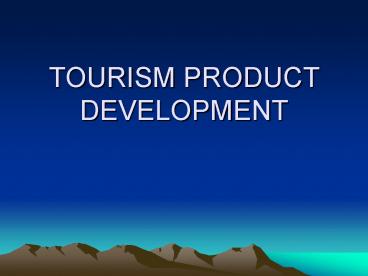TOURISM PRODUCT DEVELOPMENT - PowerPoint PPT Presentation
1 / 16
Title:
TOURISM PRODUCT DEVELOPMENT
Description:
Encourage quality through regulations and certification programs ... Fitness and Sports. Relaxation and Rejuvenation. Lifestyle Modification ... – PowerPoint PPT presentation
Number of Views:4216
Avg rating:3.0/5.0
Title: TOURISM PRODUCT DEVELOPMENT
1
TOURISM PRODUCT DEVELOPMENT
2
INPUT TO PRODUCT DEVELOPMENT
DEMAND Factors (Push)
SUPPLY Factors (Pull)
Product Development
3
Destination Life Cycle
rejuvenation
tourists
reduced growth
stagnation
stabilisation
Critical range
decline
consolidation
immediate decline
development
involvement
exploration
Time
After Butler and Swarbrooke
4
Strategic Directions
Current
Consolidation Market Penetration
Product Development
Market
Market Development
Diversification
New
New
Product
Current
Withdrawal is another option
5
Market Development Diversification
- Based on Competitive Advantage
- Geographic
- Demographic Psychographic
- Behavioral
- Niche markets based on interest
- Adventure
- Sports
- Health and Welllness
- Educational tourism
- Food and wine
- Shopping
- Cultural interest
6
Product DevelopmentAttractions
NATURAL water coasts forests, mountains
eco-tourism
MAN-MADE Theme parks, museums, aquariums,
historic sites, golf courses
EVENT Festivals, Sports, Conferences, Theater,
Golf Tournaments,
COMMUNITY-BASED home stays, working holidays
traveler philanthropy, bed breakfast,
agri-tourism
7
Ownership of attractions
- Government
- National state parks
- Hiking trails
- National monuments
- Wild-life reserves
- Business Sector
- Theme parks
- Sports facilities
- Shopping centers
- All-inclusive resorts
- Conference centers
- Non-profit organizations
- Museums
- Festivals and parades
- Gardens
- Sacred sites
- Universities
- e.g. Polynesian Cultural Center
- Joint ownership/partnerships
- e.g. Nature Arctic Tourism project
- World Wide Fund for Nature
- Tour operators
- Polar scientists
- Local national govts
- Community representatives
- Tourism academics
8
- Different mission foci
- profit maximization
- tempered profit maximization (e.g. good neighbor
policy) - indirect profit maximization (associations)
- social aims
- Need Coordinated Destination Strategy
9
Product DevelopmentFacilities Infrastructure
- Encourage quality through regulations and
certification programs - Encourage investment in the destination through
fiscal policies - Improve information and interpretative programs
- Add products that will increase length of stay,
spending seasonality - Encourage innovative accommodation styles (sense
of place) - Include information technologies GIS, GPS,
Intelligent Transportation Systems, mobile
applications
10
Planning Management Issues
- Land use decisions
- Purpose (residents/tourists(intl or domestic))
- Carrying capacity environmental issues
- Interpretation visitor centers
- Clustering of attractions
- Rural or urban
- Access (transportation information)
- Services concessions
11
Consolidation and Market Penetration
- Repeat visitor characteristics
- Product Maturity must be dealt with
- Lack of refurbishment of facilities
- Improve infrastructure and parks etc.
- Inapproriate tourist behavior
- Loyalty programs
12
Community Tourism
- Careful Resource Analysis by community
- Community Education/Awareness programs
legitimacy of tourism - local input to goals and marketing of tourism
(especially from minority/native peoples) - Resident attitudes research
- Identification of Community leaders
- Creation of innovative marketing programs
- Identification of funding programs
- Education and training in entrepreneurial skills
and guest contact skills
13
Heritage Tourism
- Physical reminders of the past
- castles, temples, pyramids, monuments, houses,
archaeological sites, religious sacred sites...
SPATIAL MODEL
Inviolate belt Essential setting
Nucleus Principal Attracting force
Zone of closure Outer area of influence
includes service center or community
14
Types of Wellness Tourism(body, mind, spirit)
- Diagnosis and Treatment
- Fitness and Sports
- Relaxation and Rejuvenation
- Lifestyle Modification
- Eco-tourism/nature as healer
- Travel to serve
- Inner seeking/spiritual quest
15
(No Transcript)
16
(No Transcript)































